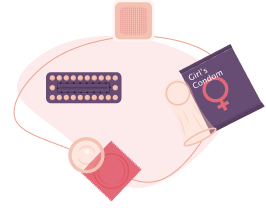
Progesterone-Releasing Vaginal Ring
Hormonal Method
The Progesterone-Releasing Vaginal Ring is also commonly referred to as “Vaginal Ring”.
The Vaginal Ring is a flexible ring that contains progestin hormone and is inserted into the vagina to prevent pregnancy in actively breastfeeding mothers.
The ring is worn for about 90s days before being replaced by another and can be started at least four to nine weeks after giving birth.
How it works
It works by preventing the release of an egg from the ovaries and also thinning the lining of the uterus.Common Types of Vaginal Rings
The common types of vaginal rings include the combined hormonal vaginal rings and progestin-only vaginal rings.Effectiveness
- When the vaginal ring is used consistently and correctly, effectiveness is over 98%.
Advantages
-
- The woman can insert and remove the ring by herself at home.
- This method does not affect milk production or composition in breastfeeding women.
- Return to fertility is immediately after removal.


Limitations
- Not suitable for women who are not actively breastfeeding (at least 4 episodes in a day)
- Does not protect against HIV infection (AIDS) and other sexually transmitted infections (STIs)
Side Effects experienced by some users
- Changes in bleeding patterns such as lighter bleeding and fewer days of bleeding, irregular bleeding, infrequent bleeding, prolonged bleeding, no monthly bleeding
- Irritation, redness, or inflammation of the vagina, or Vaginal discharge
- Breast discomfort
- Lower abdominal pains

Juu life ni kujipanga!
Popular questions
You will get a small injection on your arm to numb you. This means you won’t feel pain at all during insertion. There will be a little pain or soreness as the wound heals for about a week.
Yes. A woman who has not had children generally can use an IUD, but she should understand that the IUD is more likely to come out because her uterus may be smaller than the uterus of a woman who has given birth.
Yes. If needed, ECPs can be taken again, even in the same cycle. A woman who needs ECPs often may want to consider a longer-acting and more effective family planning method
Yes. A woman who has not had children generally can use an IUD, but she should understand that the IUD is more likely to come out because her uterus may be smaller than the uterus of a woman who has given birth.
No. Most research finds no major changes in bleeding patterns after female sterilization. If a woman was using a hormonal method or IUD before sterilization, her bleeding pattern will return to the way it was before she used these methods



